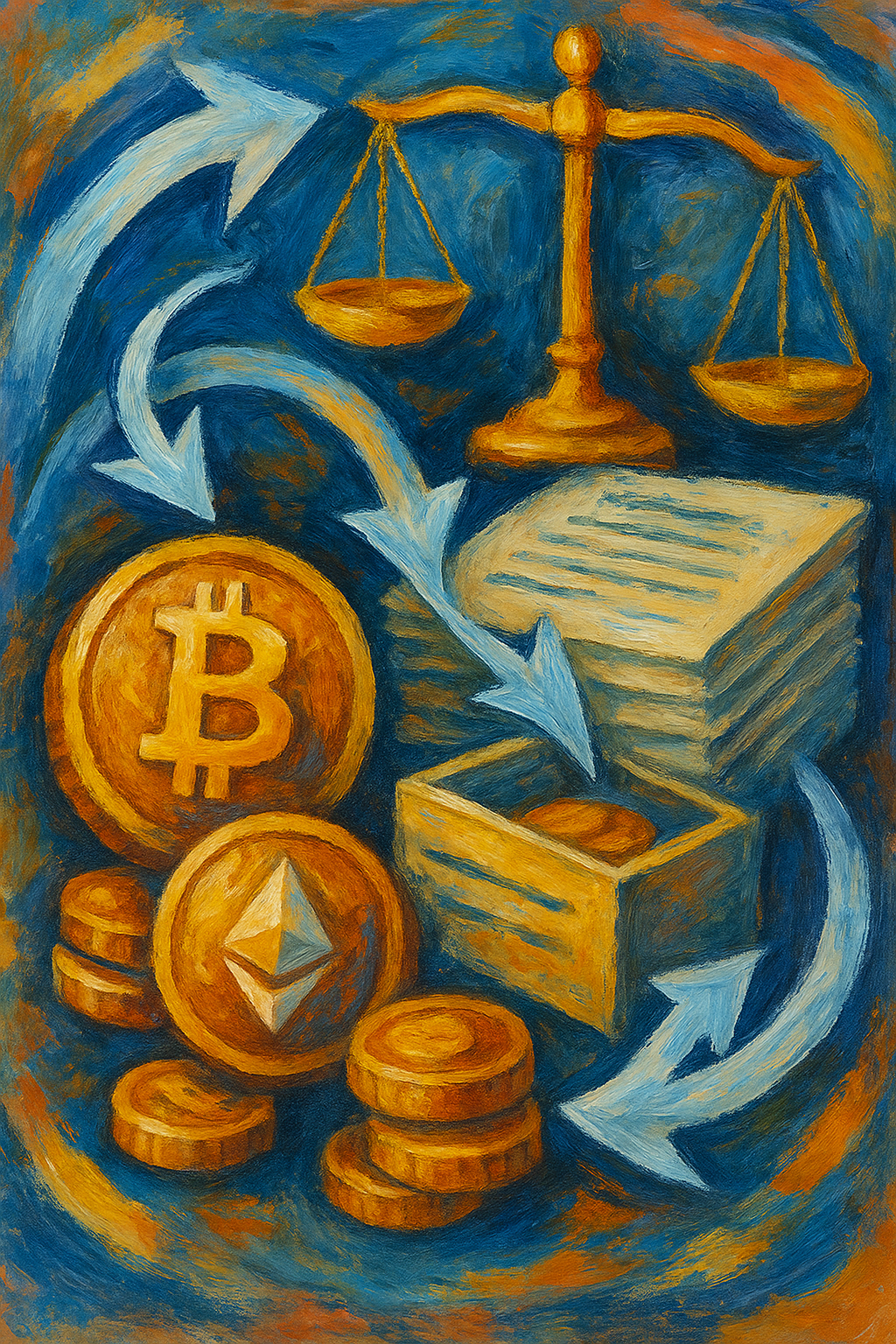
Introduction
The U.S. Securities and Exchange Commission (SEC) took another step toward mainstreaming cryptocurrency investment products in July 2025. In quick succession, the agency’s staff issued a 12‑page disclosure guidance for crypto asset exchange‑traded products (ETPs) and, days later, the Commission voted to permit in‑kind creations and redemptions for bitcoin and ether ETPs. Together, these moves signal a dramatic shift away from the agency’s historic caution and toward a future where crypto assets are treated more like traditional commodities.
In this article we unpack the details of the SEC’s guidance, explain what in‑kind creations and redemptions mean, and explore how these changes could pave the way for a new generation of crypto‑linked ETFs. Whether you’re an issuer preparing a registration statement or an investor curious about what’s next, this deep dive provides the context you need.
What are Crypto ETPs and Why Have They Been Controversial?
Exchange‑traded products are securities that trade on stock exchanges and track the price of an underlying asset or index. A crypto ETP holds bitcoin, ether or other tokens and issues shares backed 1:1 by the underlying assets. The structure offers investors exposure to crypto without having to custody keys, but it also raises unique questions about custody, liquidity, and market manipulation.
Until recently, U.S. regulators had only approved futures‑based crypto ETFs. Early in 2025 the SEC finally authorized spot bitcoin and ether ETPs but required that all share creations
Inside the SEC’s 12‑Page Guidance
On July 1, 2025, the SEC’s Division of Corporation Finance released a 12‑page statement clarifying disclosure expectations for crypto ETP issuers. The guidance covers every section of a registration statement and emphasizes plain‑English explanations of crypto‑specific risks. Key points include:
- Cover page and prospectus summary. Issuers should state the investment objective, identify authorized participants, describe the underlying crypto assets and networks, and explain how shares will be created and redeemed. Investors must be told that the amount of crypto per share will decline over time as the issuer sells assets to pay fees.
- Risk factors. The statement urges issuers to focus on risks specific to their assets and operations rather than generic market risks. Examples include volatility, custodial hacks, concentration of ownership, fraud and manipulation on trading platforms, and competition from funds with lower fees.
- Description of business and assets. Issuers should describe the crypto assets and networks, including total supply, market capitalization, and the sponsors’ policies on forks, airdrops, and staking. They should also detail how the net asset value (NAV) is calculated and identify each trading platform used in benchmark indexes.
- Third‑party relationships and custody. The guidance requires disclosure of all material contracts with custodians, brokers and other service providers, along with fees paid to those parties. Issuers must explain custody arrangements, including storage policies and insurance coverage.
- Plan of distribution. The SEC wants issuers to spell out the mechanics of the creation and redemption process and disclose whether orders settle on‑chain or off‑chain. This includes whether authorized participants will conduct in‑kind exchanges.
Importantly, the statement is not a rule but rather a road map. It helps issuers prepare re
In‑Kind Creations and Redemptions: A Game‑Changer
On July 29, 2025, the SEC went a step further by approving orders that permit in‑kind creations and redemptions for bitcoin and ether ETP shares. Prior spot ETP approvals had limited transactions to cash, creating friction for market makers. The new orders bring crypto ETPs in line with gold and commodity funds by allowing authorized participants to deliver crypto directly in exchange for new shares and to receive crypto when redeeming shares.
SEC Chairman Paul S. Atkins hailed the decision as part of a “fit‑for‑purpose regulatory framework” for crypto. Jamie Selway, head of the Division of Trading and Markets, noted that in‑kind transactions provide flexibility and cost savings and result in a more efficient market. The Commission simultaneously approved other measures, such as approving exchange applications to list a mixed bitcoin‑ether ETP and authorizing options on spot bitcoin ETPs.
For issuers and authorized participants, in‑kind transactions reduce the need to hold large cash balances and lower tax friction. When a participant can deliver bitcoin instead of cash to create new shares, it avoids triggering capital gains taxes on a sale. Investors benefit because in‑kind redemptions generally keep share prices closer to NAV; when shares trade at a discount, arbitrageurs can redeem them for crypto and profit until the spread closes.
Implications for the ETF Pipeline
Industry observers expect these moves to unleash a flurry of new filings. Dozens of pending applications seek to offer ETFs tied to Solana, XRP, Cardano, Dogecoin and even meme coins. With clear disclosure guidance and the ability to transact in‑kind, asset managers anticipate a more streamlined process. Some participants have noted that the SEC is working on a general listing rule to replace the case‑by‑case filings required under Rule 19(b)‑4, which could shorten the approval timeline from as much as 240 days to 75 days.
Potential Winners and Losers
- Issuers and exchanges. Large issuers like BlackRock and Fidelity are well‑positioned to launch new products quickly, while smaller firms may struggle to meet the disclosure and custody requirements. Exchanges that develop standardized listing rules may gain a first‑mover advantage.
- Investors. Retail investors gain access to diversified crypto exposure without the complexities of self‑custody. Institutional investors benefit from lower spreads and more efficient trading, though they must still evaluate each fund’s disclosures carefully.
- Underlying tokens. Coins like Solana, Polkadot and XRP could see increased demand if ETFs tied to them are approved. However, tokens with smaller markets or high concentration of supply may face delays due to liquidity and manipulation concerns.
Preparing for the New Regime
If you’re an issuer planning to file a crypto ETP registration statement, start by reviewing the SEC’s guidance. Make sure your prospectus clearly explains the crypto assets held, custody arrangements, third‑party relationships, and how shares will be created and redeemed. Consult with experienced counsel on how to disclose forks and airdrops and whether your fund will stake assets or participate in decentralized finance protocols.
For investors, the main takeaway is that the regulatory environment is evolving. New products may offer attractive exposure, but each fund is unique. Read the prospectus carefully, paying attention to risk factors, custody details, fee structures and policies on forks and staking. Consider diversifying across multiple funds and using limit orders when trading to avoid large spreads.
FAQs
What is an in‑kind creation and redemption?
An in‑kind creation occurs when an authorized participant delivers the underlying crypto assets (e.g., bitcoin or ether) to the fund in exchange for new ETP shares. An in‑kind redemption is the opposite: the fund delivers crypto back to the participant when they redeem shares. This process avoids the need to sell assets for cash and reduces tax friction.
How does the SEC guidance accelerate ETF approvals?
The 12‑page statement clarifies what the SEC expects in registration filings, which helps issuers avoid repeated comment letters and delays. Regulators are also working on a general listing rule that would let exchanges approve crypto ETPs without submitting separate filings for each product.
Will altcoin ETFs be approved soon?
Dozens of applications are pending, and industry participants expect the next wave of products to include Solana and XRP ETFs. However, approvals may not come until after the SEC finishes its second phase of guidance and finalizes a general listing rule.
What risks should investors watch?
Beyond market volatility, investors should consider custody arrangements, insurance coverage, potential forks, regulatory changes and differences in NAV calculation. Funds must disclose these risks under the SEC guidance.
Conclusion
The SEC’s July 2025 guidance and approval of in‑kind creations mark the most significant steps yet toward integrating crypto assets into the U.S. financial system. By clarifying disclosure requirements and aligning crypto ETP mechanics with traditional commodity funds, regulators are laying the groundwork for a robust and diverse market of digital‑asset ETFs. As rules evolve and new products emerge, issuers and investors alike should remain engaged, informed and cautious.
Despite the enthusiasm, the guidance sets a high bar for risk disclosure. Issuers must address network security, liquidity, market manipulation and custodial challenges. They also need to explain how they handle forks, airdrops and staking rewards. Funds that plan to lend or stake their assets will face additional scrutiny, and stablecoin‑backed funds may need to comply with the new GENIUS Act’s 100% reserve requirement.
gistration statements that address the SEC’s concerns without requiring them to guess at staff expectations. Industry participants have said the most significant aspect of the guidance is simply that it exists, signaling that the Commission acknowledges crypto ETPs are part of mainstream finance. Asset managers hope this will shorten the approval timeline and make the process more predictable.
and redemptions occur in cash, not the underlying crypto asset. This cash‑only rule hindered operational efficiency and kept crypto ETPs from functioning like traditional commodity funds, where market makers deliver and receive the underlying asset. Issuers and investors argued that in‑kind transactions—exchanging crypto for shares and vice‑versa—would reduce spreads and better align ETP prices with net asset value.



